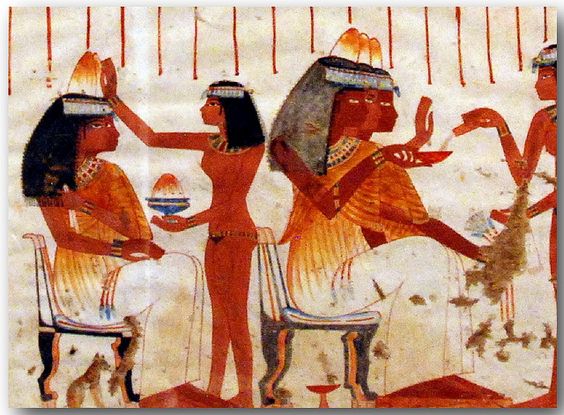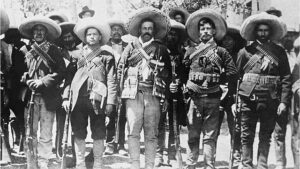The Egyptians, along with the other ancient civilizations, were complex societies. Their culture has many similarities with modern societies, one of which was their concern for beauty. Egyptians went to great lengths to ensure that they were portrayed as flatteringly as possible, rarely depicting their true age. Youth was seen as central to their concept of beauty.

When one looks at human depictions in the artwork of the ancient Egyptians, one may notice the black lines around their eyes. Upon closer attention to detail, one notices that it resembles the way girls today apply eyeliner. This is what was intriguing enough to spark questions about the Egyptian society’s views on cosmetics. Was it a statement of beauty? Of power? Did it relate to their status?
There is evidence to support the generalization that Egyptians may in fact have valued beauty even more than we do today. They expressed their fondness for beauty in their artwork. Their sculptures and paintings provide evidence for how they valued beauty. The value they saw in beauty is depicted in their paintings and sculptures, such as the bust of Nefertiti, which was made to make her look flawless. They also used eye paints (similar to today’s eyeliner), and it was typically made from malachite and galena. Eventually galena became the country’s primary eye paint, and both are found in tombs on pallets and stones that are believed to have been used in preparation of the paints.1
The image to the left is a statue from the Egyptian Museum of Cairo. This statue gives us a visual representation of the ideal form of a male. One may notice the square, wide shoulders, a slim, muscular figure, and a very defined face shape.

The image to the left is a bust of Nefertiti, the great Royal Wife of the Pharaoh Akhenaten. It is believed to be sculpted by Thutmose, who is believed to be the official court sculptor of Pharaoh Akhenaten.2 It was recovered in his workshop and is believed to have been sculpted in 1345 BCE. Nefertiti was a staple for beauty in her time, and her husband strove to make her co-equal with himself, making her one of the most powerful women ever to rule. Nefertiti was universally portrayed as beautiful, and her beauty can still be appreciated today. As one can see in this bust, the queen was sculpted to depict an exemplar of beauty, with a slim face, painted lips, long neck, and adornments on her head and clothes.3
It seems that maybe the Egyptians were more beauty crazed than people of our generation. It is apparent that the ancient Egyptians did not find pride or beauty in older ages. They preferred to alter the way they looked, instead of having themselves accurately represented. It gives us the impression that maybe this ancient culture is not as different from ours as we may have initially assumed.
- A. Lucas, “Cosmetics, Perfumes and Incense in Ancient Egypt,” The Journal of Egyptian Archaeology 16, no. 1/2 (1930): 41. ↵
- Who’s Who in Ancient Egypt, Routledge, 2003. s.v. “Thutmose (c. 1352 – 1366 BC), ” by Michael Rice. ↵
- Thutmose. Bust of Queen Nefertiti, Egyptian Museum Berlin, n.d. http://www.egyptian-museum-berlin.com/c53.php. ↵



65 comments
Lamont Traylor
I believe that the woman of Egypt may have cared more about beauty in those ancient times than people of today’s society do. I feel like the Egyptian women cared more about beauty but only the woman in power such as the pharaohs wife. Other than that I couldn’t imagine the poorer women caring as much about what they looked like as they are struggling to eat and take care of their family.
Annissa Noblejas
The standard of beauty is an ever-changing concept but it is evident that the ancient Egyptian people held it in high regard. To be young and strong was to be beautiful, and that is how they wished to be portrayed in all aspects of life. The use of cosmetics to alter a person’s appearance is a beauty norm that has lasted through the ages.
Roman Olivera
I definitely think that Egyptian culture was obsessed with ones physical beauty as well as all things pleasing to the eye. We can see it not only from the art work and sculptures left behind, but also by the use of gold, gems and fabrics to bring so much color to the history of the Egyptians. Do I believe they are more obsessed with it then in today’s society…I don’t know about that. Today’s beauty culture has far more avenues to turn when it comes to the person perception of beauty. I think both men and women today have far more things to worry about when it comes to keeping up their appearance, to include option that would have never been used in the past for risks of dying, surgically altering appearances through plastic surgery. I think our society is way over the top as far as what they do with makeup, clothes and surgery for their obsession with beauty and the ancient Egypt can rest inn second place in that category.
Clarissa Gonzalez
In my mind, I had always known Egyptians viewed beauty as something extremely important, very similar to how we are in this time and place. The ways that they would have statues and drawings altered to how they truly look, is a mirror of today’s Photoshop. In addition to this, men also had a standard to meet, in contrary to many people’s expectations. This article, though short, highlights very important data to understand the overview of beauty in Egyptian history.
Hailey Stewart
I have always romanticized Ancient Egyptian culture in my head. One can paint many similarities between now and then when it comes to the culture of aesthetics and outward appearance. As to answering the question posed in the title of the article, I believe that also men, just as much as women, were concerned with ‘beauty’ in Ancient Egypt, seen in the example of the male statue. What the majority of people usually overlook is the fact that men are also held to a standard of masculinity in the same way women are held to beauty standards. Although this article is short, the reader can gather highlights of the beauty of Egyptian culture, but also the undertones of how high their beauty standards were.
Luisa Ortiz
Reading this article made me think in today’s beauty “standard” and how girls, woman and even some boys use make up to enhance their natural beauty. I like the idea of “mirror” ancient women vs modern woman. It makes me think how back then they use make to to alter their image just like if today we would it use Photoshop, or a filter in snap-chat!
Natalia Flores
It astounds me that the concept of beauty is very similar to today’s standard of beauty. Let’s face it. Even if we claim that everyone is beautiful, there is a clear standard that beauty is painted face and young in our modern society. That standard is the same in Egyptian society and is seen through the use of the eyeliner like makeup the author points out. Overall, very intriguing article.
Anais Del Rio
I would say that in this case history hasn’t really changed. Today across many cultures women try to change their appearance with make up or surgery to fit in into the standards of their country’s beauty or the world’s standard of beauty. Another example that is like the Egyptians was the Europeans especially the queens. In paintings women were depicted extremely pale and usually different than their actual appearance.
Anna Guaderrama
Does not seem like a new concept but it’s an interesting idea to think about. I mean, nowadays we pay attention to beauty to a certain extent, but in a different light. Youth today I’ve noticed that isn’t much of an idealized concept anymore because makeup and cosmetic surgery basically can fix everything. We live in an age of fake beauty and plastered false advertising to products and procedures that promise no real fixes.
Destiny Flores
It’s obvious the egyptians were devoted to their beauty. They have the iconic eyeliner tradition as well as an obsession with jewelry. It makes sense for both to signify status among society. Although short, the article was informative, especially mentioning where the makeup was derived from and the fact that they even went as far as putting it on tombs.